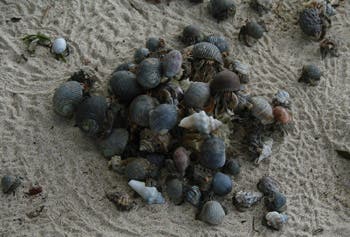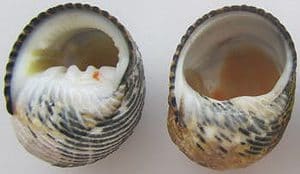There are around 800 hermit crab species living in the ocean. These crustaceans like to mind their own business and are rarely seen alongside one another, hence their species’ name. The dozen or so terrestrial hermit crab species, however, are forced to engage socially in order to survive. Their social pattern reveals a selfish agenda, though, after a recent study by biologists at Berkeley University found a vicious behavior – the land hermit crabs gather and kick other crabs out of their shell, in order to move in it.

Wrapped in a free for all tug of war, the hermit crabs stack as each is looking to displace its shell for a more spacious one.
These hustling hermit crabs have been forced to adapt this way, though one might suggest that evolution could have brought them down a more altruistic path. Typically, ocean hermit crabs use empty snail shells that are abundant through out as shelter and egg deposits. On land however, the only empty snail shells available are the few that happen to wash ashore. Pushed by scarcity, the terrestrial hermit crab adapted and developed a unique trait, distinct from their ocean dwelling cousins – they’re the only ones that hollow out and remodel their shells, sometimes doubling the internal volume.
Even with this impressive skill, however, the hermit crab still winds up in trouble since sooner or later it will outgrow its shell. In order to survive, the hermit crabs developed a sort of sacrificial social gathering. Thus, as three or more crabs gather around, others flock by the dozens as well, eager to trade up. Curiously, they first line up in a sort of conga line, smallest to largest by the shell, each holding on to the crab next to him. As they trade shells, most of the time the largest of the group gets more than he bargained for when he first joined, as he gets wrenched from its shell .
“The one that gets yanked out of its shell is often left with the smallest shell, which it can’t really protect itself with,” said Mark Laidre, a UC Berkeley Miller Post-Doctoral Fellow, who is in the Department of Integrative Biology. “Then it’s liable to be eaten by anything. For hermit crabs, it’s really their sociality that drives predation.”

A marine snail shell newly vacated by its gastropod owner (left) and a shell that has been remodeled by a hermit crab.
If they can modify shells themselves, why trick their brethren in such a despicable manner? Well, in an experiment in which Laidre and colleagues pulled crabs from their homes and instead offered them newly vacated snail shells, the researchers found that only the smallest hermit crabs took advantage of new shells, as they’re the only ones to fit in and thus begin the remodeling process. The rest perish.
Laidre believes this behavior to be an excellent example of how niche construction leads to unusual traits, like this out of the ordinary socialization in an otherwise solitary animal.
“No matter how exactly the hermit tenants modify their shellters, they exemplify an important, if obvious, evolutionary truth: living things have been altering and remodeling their surroundings throughout the history of life,” wrote UC Davis evolutionary biologist Geerat J. Vermeij in a commentary in the same journal.
Findings were documented in the journal Current Biology.
source: Berkeley Newsroom









